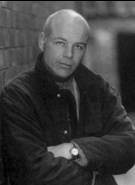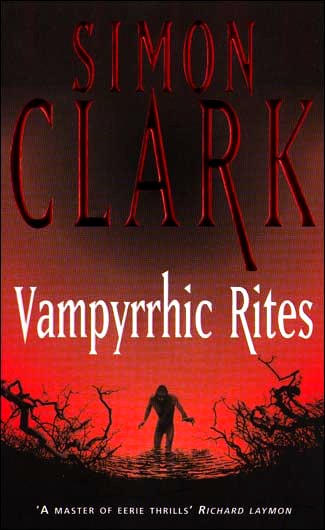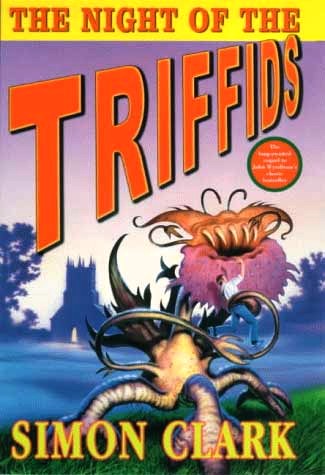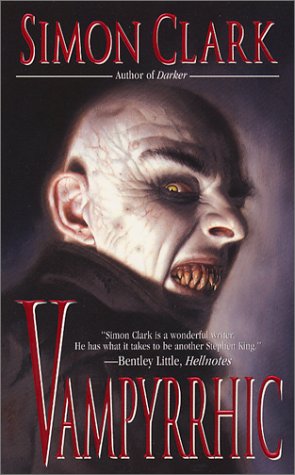
Simon Clark is one of the most successful horror writers working today. His books include Nailed by the Heart, Blood Crazy, The Fall and Night of the Triffids. In 2002 he won not one, but two British Fantasy Awards. Here Paul Kane chats to the man some call 'The British Stephen King'.
Paul Kane: Your new book is Vampyrrhic Rites, a sequel to the very popular Vampyrrhic. For those who don't know can you tell us a bit about the original.
Simon Clark: Vampyrrhic tells the story of a modern day every-man returning to his hometown of Leppington. His name is David Leppington and it's no coincidence that he shares his name with the town. He learns that his family have a dark Viking ancestry. They once commanded an army of vampiric creatures that now inhabit a labyrinth of tunnels beneath the town.

Paul Kane: What about the new novel?
Simon Clark: Well, the story picks up from Vampyrrhic a few years on when the central characters have gone their separate ways. Unknown to them the vampire creatures are back but instead of surging up from the caves beneath the town they are emerging from a lake called Lazarus Deep. David Leppington and his friends return to battle with their enemy on the North Yorkshire Moors.
Paul Kane: What were your influences and inspirations for these books?
Simon Clark: I read Stoker's Dracula many years ago, and saw the old Hammer horror films, but if anything it's the old coastal town of Whitby and the surrounding countryside that was the real inspiration. It's such a beautiful and haunting place. The Welsh writer Arthur Machen said Whitby was 'the town of a magic dream'. And it is, there's something inspirational about the place.

Paul Kane: I know what you mean, having visited it again just recently. It's a very atmospheric spot...
Simon Clark: It certainly is. Every time I go there I come back home with an idea for another story. It's a town of odd coincidences, too. A couple of years ago I'd just finished writing a novel and was more than ready for a break. So I grabbed a holiday brochure and booked a flat almost at random. When we got there we found not only were we staying in the same house on Royal Crescent where Stoker found the inspiration to write Dracula, I was sleeping in the same bedroom, too. Before writing Vampyrrhic Rites I rented a house in the village of Danby in the Esk Valley to soak up the atmosphere. It's such an evocative place I can almost feel story ideas growing out of the ground. If anything it's seeing those hills and streams and dramatic valleys, and imagining my characters in that scenery that inspires the story.
Paul Kane: Can you tell us a little about your background as a writer. How did you first start writing and what did you do before becoming a full-time writer?
Simon Clark: There's always this debate about writers being born or made. I think the desire to tell stories is in the blood. I was always telling stories in my youth. Then, when I was about twelve I was walking across the fields where I lived and I suddenly said to myself, 'When I grow up I want to become a writer.' From that day I never had any other ambition in life. I was hopeless at most other subjects, especially dreaded maths! But if I could get away with writing a story, whether in English or History, that's when I shone. By the age of sixteen I was sending stories to science fiction magazines and poetry to the small press. All my science fiction was rejected but some pieces of poetry were accepted. That was a tremendous moment. Elated doesn't even do the emotion justice. I was walking on air. Of course, I couldn't simply stay home and write, so when I left Whitwood Mining and Technical College I found work in a supermarket, then at Wakefield District Council. But I wrote in the evenings, gaining more acceptances in the small press.
Paul Kane: The big breakthrough for you came with your first novel, Nailed by the Heart: a zombie siege story set in another coastal location. How did you go about writing and selling this?
Simon Clark: Writing that first novel was a big step. I still had the day job and knew it would take a couple of years to write. A couple of wasted years if I didn't find a publisher. By that time I'd had more success writing for radio and magazines and paying anthologies, so I did feel more confident. But to be honest I made big mistakes. I put too much description in the book. I found myself trying to write like the authors I admired. Writing the novel got harder and slower. Then I told myself, 'Look, this novel might never be published but if you're going to write it, write it for yourself and in your own style. Stop pretending to be another writer!' So I did exactly that. I wrote Nailed by the Heart for my own enjoyment. As soon as I did that I found the story coming more easily, the prose became fluid and suddenly the story took off. I then picked agents out of the writer's handbooks and after querying some to find out if they'd look at the manuscript I started sending it out. One loved it but said, bizarrely, they could only sell it if it was turned into a crime story!
Then another liked it but thought there should be cuts. This agent invited me down to her office in London where we spent the best part of a day going through the manuscript, editing there and then. I have to say she was brilliant. I learnt a heck of a lot about writing in those few hours. I returned home, revised the novel, then sent it back to the agent. Then heard nothing. In the meantime she'd left the agency. Talk about a crisis! With only the carbon copy of the manuscript left - this was before I owned a computer - I was in a real mess. What now? So, I thought, 'Blow it.' Then did what you shouldn't do. I sent the carbon copy to Hodder & Stoughton. But miraculously it made it through the slush pile to a wonderful editor called Nick Austin. He bought Nailed by the Heart and my second novel Blood Crazy in one fell swoop. This was in 1994. Ever since then Hodder, who put so much faith in an unknown writer, kept renewing the contracts. Vampyrrhic Rites is my ninth novel for them.
Paul Kane: You're very much into the whole post 'apocalyptic' scene, as novels like Blood Crazy, King Blood and Stranger testify. Where did this come from?
Simon Clark: I loved TV series like Terry Nation's Survivors, films like The Flight of the Phoenix and novels by John Wyndham, such as The Day of the Triffids and The Kraken Wakes.

Paul Kane: Which explains why you wanted to write the sequel to Triffids. How did that come about?
Simon Clark: I always wanted to continue the story, ever since I first read it. But one day I was travelling on a train when the country was hit by floods. It was taking hours for this inter-city express to make a half hour journey. Then a bird flew into the front of the train and delayed it even more. 'My God,' I thought, 'this could be out of a John Wyndham story.' That started me thinking about Triffids and a few minutes later I realised what I wanted to write next was a continuation of The Day of the Triffids. I wrote an outline and sample chapters of The Night of the Triffids and my agent sent it to the estate of Wyndham. They liked what they saw and agreed to my writing the book.
Paul Kane: You've written ghostly novels like Judas Tree, which was very much in the tradition of Shirley Jackson's The Haunting of Hill House. Do you have any real-life spooky experiences you can tell us about?
Simon Clark: I'm an inveterate cemetery visitor. This isn't morbid. After all, that's what the people interred there would have wanted, wouldn't they? They didn't want to be forgotten. So reading the Victorian gravestones, and so on, keeps that memory alive. There's something spell-binding about it, too, catching those glimpses of our ancestors lives engraved on headstones. On one such visit, though, I got a hell of a scare. I'd been walking round the Kensal Green Cemetery in London and noticed a large tomb had been eroded so a hole had formed in one of the vertical slabs. Talk about curiosity killing the cat. I decided to put my hand through the hole while holding the camera and take a photograph. As soon as the flash went off - with my hand and arm firmly in the tomb - there was commotion inside: a scratching and clamouring. I'd woken something that didn't want waking. Like greased lightning I withdrew my hand and retreated to the safety of a nearby pub. Of course later I couldn't wait to get the film developed. I took it to a one hour processors then paced about until my prints were ready. I'd thought that the tomb was an empty structure sitting over the graves, but I was proved wrong. The photograph revealed two Victorian coffins lying side by side. Touchingly, there was still the ghost pattern of a bunch of flowers lying on one of the coffin lids with the dusty remains of a ribbon. The only thing the photograph didn't show was what kicked up a fuss when the camera flashed. Mice or rats? Or maybe it's better not to speculate...
Paul Kane: How and where do you write best? And what's your time-frame for penning a novel?
Simon Clark: I write at home in what was once the dining room and which I have now commandeered as my office. My wife lives in the hope that it will become a dining room again one day and I'll move all my books and stacks of manuscripts and computers to a different part of the house - or, better still, a shed at the bottom of the garden. After having a day job for so long, I keep office hours, nine 'till five. This gives me plenty of time with my family in the evening and at weekends. Although like most writers I can still find myself checking proofs or vetting contracts on bank holidays when neighbours are firing up their barbecues. As for how I go about writing a novel, I have an outline when I begin writing the first chapter. But by the second paragraph of that first chapter I've thrown the outline away. Once the characters and story take hold in my mind the plot steers its own course. When I first started writing I'd work longhand then laboriously type-up. Now I write directly onto the computer. It allows me to write more freely in a stream of (un)consciousness kind of way, which, for me, is more exciting and satisfying. Time-wise there's always that contractual deadline sitting there at a particular date like a brick wall which I know I can't pass, so I generally allow myself around nine months to gestate the book. And there seems something very natural about that period of time.
Paul Kane: What are your thoughts on the horror genre at the moment, and what has your experience been like of selling material to the US?
Simon Clark: All genre fiction has ups and downs. Horror peaked in the early nineties then went through a dip, now it appears to be climbing in popularity again. More of the big publishers, especially in America, are buying horror novels. All markets are difficult to crack. My seventh novel had appeared in Britain before a US publisher bought Nailed by the Heart, even though some of my stories were set in places that many Americans would never heard of such as Doncaster, the Lincolnshire coast and the North Yorks moors. My US publisher Leisure were so pleased with the sales from reprinting the novels they commissioned a new one from me. In retrospect I think they were hoping for a novel with an American setting but what they got was Darkness Demands, which was set in the small village of Skelbrooke just up the road from where I live. But the novel turned out to be one of their best sellers in the States.
Paul Kane: Do you think your work is more horror or sf, or a combination of both? And how has it been marketed to the public?
Simon Clark: My work is marketed as horror, apart from The Night of the Triffids, of course, which is sf. But even so a lot of my horror novels do straddle sf. Blood Crazy is an end of the world story with a scientific rather than supernatural theme, while The Fall deals with time travel, and the 'horror' of finding yourself slipping back a few minutes in time, then days, then months, then decades. When horror went through a bad patch a few years ago I think one of the reasons why my books continued to be popular when a lot of horror writers were being shed by their publishers was because sf readers were picking up on the books and enjoying them.
Paul Kane: Would you like to see any of your work filmed and is this a possibility in the future?
Simon Clark: It's always a possibility that the books might find their way onto film one day, but these things are very much in the lap of the gods. If anything, what I really did enjoy was Stephen Pacey's reading of The Night of the Triffids in the audio version. The way he gave each character their own voice was extraordinary, especially when I had all kinds of unusual ones, such as a dyed in the wool Yorkshireman who'd lived in New York for years, so the accent would be a blend of Barnsley and Brooklyn!

Paul Kane: Finally, turning back to Vampyrrhic Rites, what do you think the appeal is of vampires?
Simon Clark: Stories about the undead are very much alive. That's a fact, it's just the 'why' are vampires eternally popular. I guess critics can give all kinds of reasons but one thing that strikes me is that vampires in fiction have evolved to reflect modern society. In the ancient times vampires were ugly graveyard creatures with no more intelligence than that of a leech. Bram Stoker made his vampire an elegant and cultured Romanian aristocrat. In the later part of the 20th century vampires became modern urbanised Americans - in Matheson's I Am Legend vampires are literally the guy and gal next door. In Vampyrrhic and Vampyrrhic Rites I returned to the classic notion that vampires are the equivalent of two-legged leaches, driven by instinct and hunger, not intellect. However, with the Viking vampires in Vampyrrhic Rites - wow, that's a tongue twister - I have added more recent vampiric converts including a missing-presumed-dead rockstar and a local village boy who tries to lure his old time friend in joining the creatures that lurk in Lazarus Deep.
Paul Kane: Pleasure to talk to you, as always Simon.
Simon Clark: And you Paul.
Visit the Simon Clark website at
http://www.bbr-online.com/nailed
Interview (C) Paul Kane & Simon Clark, July 2003.